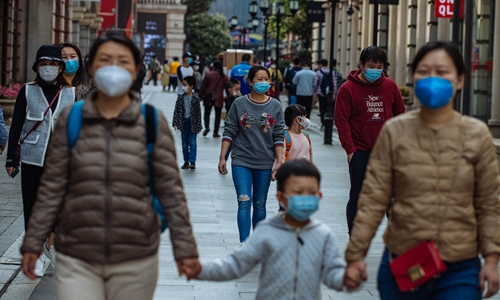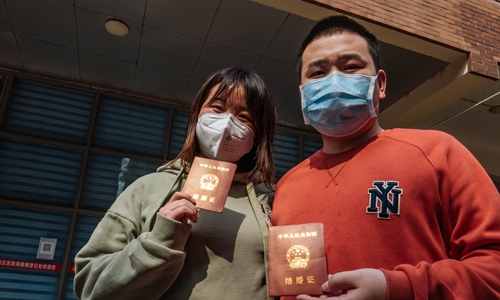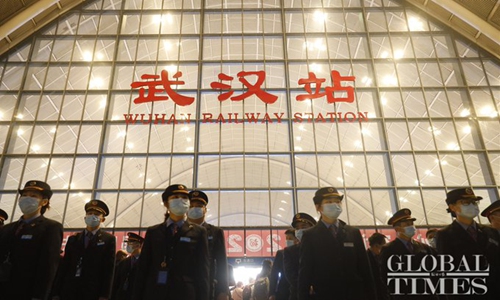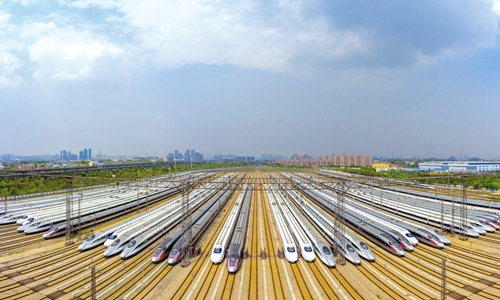Like a phoenix, Wuhan reemerges from dark coronavirus lockdown in warm spring
By Zhao Yusha in Wuhan Source:Global Times Published: 2020/4/8 21:48:40
Right time for city to open up as number of patients drop

Photo: Li Hao/GT
Those who had been staying in Wuhan since the city's lockdown to contain the COVID-19 pandemic kept asking themselves for more than two months: What do I want to do the most after the lockdown is lifted and life returns to normal?That day finally came on Wednesday.
When traffic police began pushing aside the highway roadblocks that had cut off the city's link to the outside world for the past two months; when the first train from Wuhan took hundreds of stranded passengers to their homes; when hundreds of cars crowded the city's highways during the morning rush; when crowds jammed Wuhan's famous commercial spots, Wuhan woke up after two months of lockdown.
For many Wuhan lovebirds, getting married became their greatest motive to celebrate the city's phased victory in its hard-fought battle against the virus, as couples-to-be rushed to the marriage registration.
An employee from the Wuhan district marriage registration office told the Global Times that newlyweds were spared the traditional ritual of taking oath to avoid contagion. "It does not matter, as today is a special day, a new start for me and for Wuhan," said Xu Lin, a Wuhan resident who got married on Wednesday.

Photo: Li Hao/GT
Long lines also emerged in front of Wuhan train stations, where stranded people took the train home, and Wuhan locals were eager to return to work outside the city."During the past 80 days, I promised myself I would never come back to Wuhan again," said Cao Lin, a Guizhou local who has been stranded in Wuhan since January. "But I cried when I saw the live broadcast of the lifting of Wuhan's lockdown today, and I decided to come back when Wuhan returns to normal. My heart will always be there with this strong, brave and heroic city, Cao Guangjing, deputy governor of Hubei Province, said at a Wednesday conference that the lockdown lift in Wuhan marks a decisive progress in the city's battle against the virus.

Wuhan railway station reopens 76 days after city lockdown. Photo: Li Hao/GT
Reasonable timing
But the city's lockdown easing, unavoidably, ignited suspicion from foreign media, such as the New York Times and Wall Street Journal, as they questioned whether it is too early to lift the ban, as some feared a second outbreak may engulf the city, or even other parts of China, after it re-opens. And they repeated the old line that Wuhan under-reported its real infection numbers.
Wuhan’s health commission reported only had 297 patients with fever symptoms on April 5, a sharp drop from more than 15,000 per day at its peak in January.
Wuhan reported zero new COVID-19 patient on Tuesday.
"Wuhan is one of the safest places in China, as the pain still lingers in Wuhan people's hearts, which propelled the people and government to remain on high alert to avoid contagion. And the hospitals have formed a relatively mature test and treatment mechanism for patients, not mention the number of COVID-19 patients dropping drastically in the city," said a doctor from Renmin Hospital of Wuhan University.
Doctors and nurses in Wuhan's No.7 hospital were on alert on Wednesday when increased number of workers came to receive CT and nucleic tests before they were summoned back to work in recent days.
A nurse in the hospital told the Global Times that people who came to test was three times more on Wednesday than the previous day, and many voluntarily came.
One of the testers who lives in Wuhan surnamed Xiao told the Global Times that she chose to do those tests out of responsibility for herself and others. "I am about to go to work tomorrow. It is better to know if I am the virus carrier before I go. I don't want to cause cluster contagion in my workplace, nor do I want to ruin Wuhan's hard-fought victory."
One doctor surnamed Huang from the hospital's fever clinic said that she receives about 30 patients with fever symptoms (which is usual for COVID-19 patients) on a daily basis. "Once patients with fever symptoms are discovered, we immediately conduct nucleic tests on them and report them to the district health commission."
As more and more Wuhan people travel outside the city, other Chinese cities have also ramped up tests for returnees from Wuhan to prevent further contagion. For example, Beijing requires anyone from Wuhan to the capital to undergo nucleic tests twice - once before they leave Wuhan and another after they arrive in Beijing.
Caution remains
Taxi driver Liu Qi started to work for the first time after the city was ordered a seal-off in January. "I received 30 rides today, half of my normal rides per day before the pandemic."
Liu said many Wuhan people remain on high alert, so they prefer to stay in. "Some of my colleagues refused to start work today. They preferred to wait another 14 days after the easing of the situation," said Liu, noting that asymptomatic patients are a real pain.
The COVID-19 prevention task is still arduous in Hubei as it faces increasing pressure from imported cases, and the number of asymptomatic carriers has risen recently, Cao Guangjing said.
"Easing of the lockdown means that Wuhan has been catching up with the pace of other Chinese cities' virus battle. But it does not mean we can catch a breath now," said Zeng Guang, an expert at China's National Health Commission.
Despite the easing of traffic in and out of Wuhan, residential communities in the city also enforce strict measures. Most communities only let people enter after showing their green health code and temperature tests. Some residential communities remain under lockdown, letting no one enter or exit.
Guards in Wuhan's commercial places also urged "Finnish lining up habits," which requires a certain distance to avoid contagion.
"We've been raising our guard against contagion for the past two months. It won't hurt to remain vigilant for another two months. Pollyannas will make the city's hard-won battle go up in smoke," Liu said.
Newspaper headline: Wuhan reborn like a phoenix
Posted in: SOCIETY
